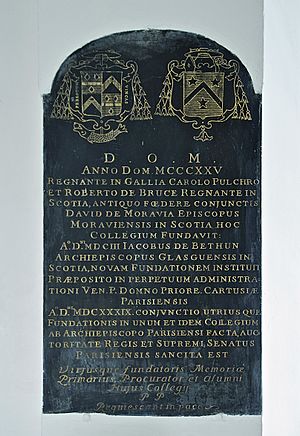James Beaton (archbishop of Glasgow) facts for kids
James Beaton (born 1517 – died 24 or 25 April 1603) was an important archbishop of Glasgow in the 1500s. He was related to the famous Cardinal David Beaton. James Beaton went to the University of Paris when he was about 14 years old, starting his studies in the 1530s.
Contents
Becoming Archbishop of Glasgow
In 1551, the position of Archbishop of Glasgow became open. Even though James Beaton was not yet a priest, Pope Julius III chose him for the role. This happened because Marie de Guise, who was the Queen-Regent of Scotland, asked for it.
Beaton was officially made archbishop on 28 August 1552 in Rome. For eight years, he managed the church in his area. He stayed loyal to Queen-Regent Marie de Guise during a time of big changes in Scotland. Many Protestant nobles were unhappy with the old ways.
The Last Council
In March 1559, Beaton attended a special church meeting in Edinburgh. This was the last time such a large church assembly would meet in Scotland for over 300 years.
Leaving Scotland for France
The year 1560 brought many challenges to Scotland. An agreement was made with England against France. Cathedrals and monasteries began to be destroyed. Also, the Queen-Regent died. These events likely made Beaton decide to leave Scotland.
He moved to Paris, France. He took many important church documents, records, and valuable church items with him. He stored these treasures at the Scots College in Paris.
Ambassador for Mary, Queen of Scots
Mary, Queen of Scots, quickly made James Beaton her ambassador in France. He remained her most loyal friend and advisor. He served her until she had to give up her throne in 1567. He continued to advise her for the rest of her life.
After the murder of Lord Darnley, Mary's husband, Beaton bravely told her about the serious suspicions against her. He also told her that the people responsible for the murder needed to be punished.
Continuing Service in Exile
In 1574, the Scottish government declared Beaton an outlaw. However, he still had the support of the young King James VI. Around 1586, King James also appointed Beaton as his ambassador in Paris, just as his mother had done.
Beaton received income from several church positions in France. He was connected to the House of Guise, a powerful French family. This led him to join a group against King Henry IV. When this group broke up, Beaton was almost sent away from France. But with help from important cardinals and the king himself, he was allowed to stay.
Return to Honor and Final Years
In 1598, almost 40 years after the old church system in Scotland changed, something remarkable happened. The Scottish Parliament officially gave Beaton back all his "inheritances, honors, dignities, and benefices." This happened even though he had never accepted the new religion in Scotland. This shows how much respect people had for him.
Beaton lived long enough to see King James VI of Scotland also become King of England. This happened just a month before Beaton died. He passed away in Paris on 24 or 25 April 1603. He was 86 years old and had been an archbishop for 50 years. King James was on his way to London to take his new throne when Beaton died.
Legacy and Archives
James Beaton lived in Paris for 43 years. He served as the Scottish ambassador to five different kings of France. He was buried in the church of St. John Lateran in Paris. Many important people attended his funeral.
A later archbishop, Spottiswoode, who was Protestant, described Beaton as "a man honourably disposed, faithful to his queen while she lived and to the king her son; a lover of his country, and liberal to all his countrymen." Beaton was known for his good character and honest life.
Beaton left his belongings, including the historical records of the Diocese of Glasgow, to the Scots College in Paris. He had also stored some documents at a monastery in Paris. During the French Revolution, many of these valuable papers were put into barrels and sent away. Sadly, these have been lost. However, the papers left at the college were safely brought to Scotland. They are now kept at the Scottish Catholic Archives in Edinburgh.


